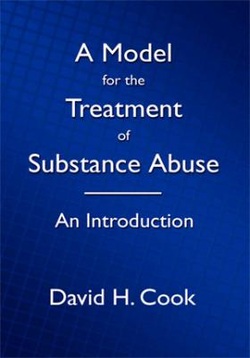About the Author:

David Cook openly describes himself in the preface to this book as a person who has stated "Hello, my name is Dave and I am an alcoholic" many times since April 22, 1987. He has donated time to his community, homeless shelters and a jail. His professional experience includes economic and financial analysis. His professional service to the community includes serving as the president of the board of trustees of a treatment center and the finance director of a domestic violence agency. He holds an honorary doctorate in humanities.
About the Book:

A Model for the Treatment of Substance Abuse - An Introduction 2007 Edition:
Hardbound Case Laminate; 7 x 10 inches; 236 pages
ISBN: 1-933912-44-8 $145.00
Substance abuse is a complex disorder with associated biological, psychological, and social causes and effects. At the community level substance abuse has been treated as a social problem, while lack of will power has been the proclamation at the individual level. Accompanying these two generalizations is the fatalistic assessment that until society takes
ownership of the solution, substance abuse will remain a social problem. Society has invested heavily in infrastructure designed to address the many issues and costs created and resulting from substance abuse, only to be frustrated by no return on investment. The primary reasons for this no return on investment have been.
(1) Treatment as society's primary tool for dealing with substance abuse with a treatment plan used to guide the delivery of treatment services.
(2) Outcomes measurement as society's primary tool for measuring the effectiveness of treatment where the abusers consumption of substances is queried at some point in time after the completion of treatment. In essence, society has opted for a process that attempts to educate the abuser to a behavior change, followed by a did-it-work query, without addressing that person's base addictive thinking, best characterized as bondage in self. This Model for a new approach to the treatment of substance abuse is built from the lack of will power generalization as a manifestation of a person's bondage in self. As such, this Model is not concerned with a person's behavior. Instead, it argues for, and outlines a methodology for the direct assessment of a person's cognitive reasoning and deduction via an incrementally constructed and measured treatment plan
Hardbound Case Laminate; 7 x 10 inches; 236 pages
ISBN: 1-933912-44-8 $145.00
Substance abuse is a complex disorder with associated biological, psychological, and social causes and effects. At the community level substance abuse has been treated as a social problem, while lack of will power has been the proclamation at the individual level. Accompanying these two generalizations is the fatalistic assessment that until society takes
ownership of the solution, substance abuse will remain a social problem. Society has invested heavily in infrastructure designed to address the many issues and costs created and resulting from substance abuse, only to be frustrated by no return on investment. The primary reasons for this no return on investment have been.
(1) Treatment as society's primary tool for dealing with substance abuse with a treatment plan used to guide the delivery of treatment services.
(2) Outcomes measurement as society's primary tool for measuring the effectiveness of treatment where the abusers consumption of substances is queried at some point in time after the completion of treatment. In essence, society has opted for a process that attempts to educate the abuser to a behavior change, followed by a did-it-work query, without addressing that person's base addictive thinking, best characterized as bondage in self. This Model for a new approach to the treatment of substance abuse is built from the lack of will power generalization as a manifestation of a person's bondage in self. As such, this Model is not concerned with a person's behavior. Instead, it argues for, and outlines a methodology for the direct assessment of a person's cognitive reasoning and deduction via an incrementally constructed and measured treatment plan